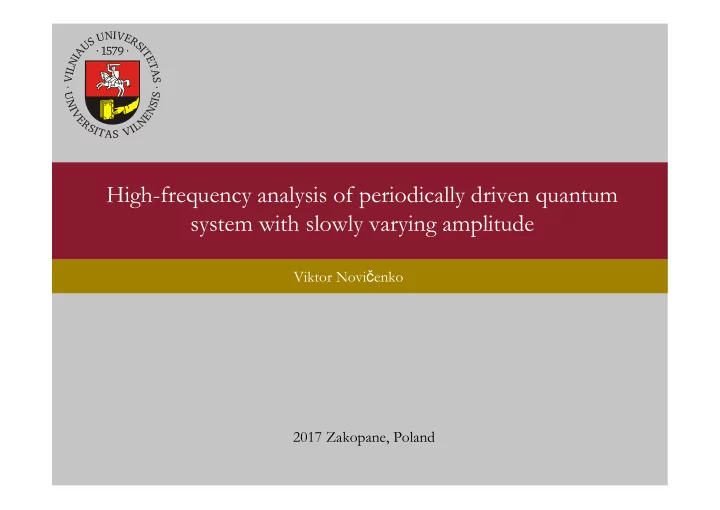

High-frequency analysis of periodically driven quantum system with slowly varying amplitude Viktor Novi č enko 2017 Zakopane, Poland
Main message φ ω φ i t H t , t t t ω π ω periodic dependence on the first argument: H t 2 , t H t , t ω any other characteristic energies of the system φ φ i t H t t eff t V. Novičenko, E. Anisimovas, G. Juzeliūnas, Phys. Rev. A 95 , 023615 (2017) Motivation shaken optical lattice R. Desbuquois, M. Messer, F. Görg, K. Sandholzer, G. Jotzu, T. Esslinger, arXiv:1703.07767 (2017)
Extension of the space Let us study whole family of the solutions: θ π φ ω θ φ initial conditions: 0 , 2 i t H t , t t θ θ t φ φ t t θ π θ 2 init init Hamiltonian acts on a Hilbert space H ω θ H t , t Introduce the space T of θ - periodic functions Construct the space L=H T ω t Apply unitary transformation U exp θ Orthonormal basis of the space T ω θ † † K U HU i U U i H , t θ e in θ n ω m n K n n 1 n m H t n n m , n where the Fourier expansion of the Hamiltonian θ , θ l il H t H t e l
“Kamiltonian” matrix ω H 0 1 2 3 1 H t t H t H t H 1 H 0 1 2 t t H t H t K t H 2 H 1 1 ω t t H 0 H t t 1 ω H 3 H 2 H 1 0 t t t H t 2 1
Floquet band structure of the “Kamiltonian” operator
Block diagonalization of the “Kamiltonian” ω † † K t D t K t D t i D t D t n H t n n D eff n ω H eff t 1 0 0 0 H eff t 0 0 0 K D t ω 0 0 0 H eff t 1 ω H t 2 1 0 0 0 eff
High-frequency expansion ω ω 3 3 D t n 1 n D t D t O H t H t H t H t O 1 2 eff eff 0 eff 1 eff 2 n ω † † D t K t D t i D t D t n H t n n eff n 0 H H eff 0 1 m H m H H , ω eff 1 m 1 m 0 m m m m m n n 1 H , H , H i H , H H , H , H H eff 2 ω 2 2 2 m 3 mn m 0 n 0 , m φ ω φ Our original problem: i t H t , t t t φ ω ω φ † t U t , t U t , t U t , t t fin Micro fin fin eff fin init Micro init init init χ χ i t H t t eff t
High-frequency expansion ω ω 3 3 D t n 1 n D t D t O H t H t H t H t O 1 2 eff eff 0 eff 1 eff 2 n ω † † D t K t D t i D t D t n H t n n eff n 0 0 H H eff 0 1 0 m H m H H , ω eff 1 m 1 m 0 m m m m m n n 1 H , H , H i H , H H , H , H H ω eff 2 2 2 2 m 3 mn m 0 n 0 , m φ ω φ Our original problem: i t H t , t t t φ ω ω φ † t U t , t U t , t U t , t t fin Micro fin fin eff fin init Micro init init init χ χ i t H t t eff t
Spin in an oscillating magnetic field The system Hamiltonian: ω F ω H t , t g B t cos t F The non-zero Fourier components: g F 1 1 F H t H t B t 2 The effective Hamiltonian is non-zero only due to “slow” time derivative: i A 1 1 H t H t H , H B ω eff eff 2 2 2 2 ω 2 where we introduce the geometric matrix valued non-Abelian vector potential A g F B F The effective evolution: t fin i T U t , init t exp A d B t eff fin t init B ϕ If and performs rotation in a plane by an angle B t const 2 2 i g B B B ϕ γ γ ϕ F U n , exp F n , where and n ϕ ϕ ω eff 2 4 B B
Numerical demonstration for a spin ½ Magnetic field amplitude: B t B e cos t e sin t z y φ Wave function: t c t c t c t 1 , c t 0 init init l 10 rotations
The end
Recommend
More recommend